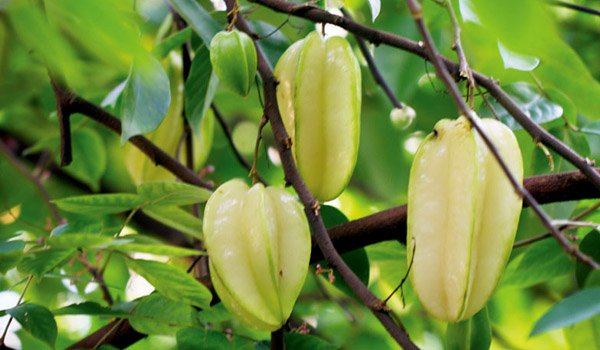The origin of the fruit is shrouded in mystery, though some claim that the fruit is a native to Sri Lanka and Moluccas. Yet others firmly believe that the fruit originated from the Indochina region or even in Malaysia and Indonesia. Regardless of its place of origin, the starfruit is now cultivated in most parts of the world including Taiwan, various provinces of China, certain regions of West Africa and Australia, and has even reached the shores of America and the South Pacific Islands.
In Sinhala, the starfruit is called kamaranga, while in ancient Ayurvedic texts detailing its many medicinal properties the fruit is called peeritha pala, rujakara and dhara. In other parts of the world it is known as kamrat in Tamil, kamrakh in India (derived from the Sanskrit term karmana), belimbing in Indo-Malay, yangtao in China, ma fueng in Thailand, khe in Vietnam and babingbing in Philippines. It is also commonly known as the carambola, both in English and Spanish, a term adopted by the Portuguese when they first encountered the fruit. It is a member of the Oxalidaceae family and was christened with its scientific name, averrhoa carambola, after a 12th Century doctor and philosopher by the name of Averroes who lived in Spain.
A warm climate is ideal for the growth of starfruit, which comes in two main varieties-sweet and tart. However, even the sweet varieties are only about four percent sugar. Propagated by seeds, the tree grows slowly to reach a height of six to nine metres with many branches and bears fruit within two years of planting. When the season comes along, the whole tree is filled with small blooms of purple or pink. In Sri Lanka the season for the fruit is July to August and December to January. While the unripened starfruit is used more as a vegetable in salads and dishes, ripe ones are recommended as fruits.
A Warm Climate Is Ideal For The Growth Of Starfruit, Which Comes In Two Main Varieties—Sweet And Tart
 Growing to about five to 18 centimetres, the surface of the fruit is smooth, taking on a shiny and almost wax like quality. The unripened star fruit appears green and firm with a very sour flavour while the colour of the ripe fruit varies from yellow to orange to even golden brown. Once the fruit is ripe you can either slice it into star shaped pieces or break it along one of its five (or sometimes six) ridges and bite into the juicy flesh. A taste that is sweet, succulent and slightly tart, without being overpowering, along with a crispy texture will fill your senses and without a doubt your hand will reach for more. To add some zest, drizzle them with some salt and pepper or even a little bit of chilli.
Growing to about five to 18 centimetres, the surface of the fruit is smooth, taking on a shiny and almost wax like quality. The unripened star fruit appears green and firm with a very sour flavour while the colour of the ripe fruit varies from yellow to orange to even golden brown. Once the fruit is ripe you can either slice it into star shaped pieces or break it along one of its five (or sometimes six) ridges and bite into the juicy flesh. A taste that is sweet, succulent and slightly tart, without being overpowering, along with a crispy texture will fill your senses and without a doubt your hand will reach for more. To add some zest, drizzle them with some salt and pepper or even a little bit of chilli.
Rich in Vitamin C and minerals such as sodium and potassium, the fruit, especially in its unripe state, is also whipped into scrumptious dishes as well as juice, dehydrated slices, jam, jelly, preserves and even canned fruit. In Malaysia, starfruit is added into salads while starfruit juice is a popular health drink in India and China. Provinces in Vietnam prefer to have the fruit in soups such as the sour soup with shrimp where starfruit is added as the main ingredient. More inventive and delicious recipes that many people love to experiment with include carambola bread, starfruit pudding and chutney, to name just a few.
Old Ayurvedic Books Tell That The Fruit Has The Ability To Provide New Life And Vigour
 In Sri Lanka the fruit is popularly used as a vegetable to add a tangy flavour to meat dishes, curries or even whipped into a curry itself. One popular recipe is to take a few thinly cut onions, green chillies, karapincha and rampe and fry them in a pan. Then take a few starfruit, slice and crush them adding a little bit of chilli, turmeric, curry powder and salt before mixing it together with the other ingredients in the frying pan. Once the mixture turns golden brown, add some coconut milk and serve as a dry dish. Another popular dish is to add some starfruit into the good old pol sambol to bring out a sharper taste. Grind chilli, onions and salt together before adding starfruit and finally the grated coconut into the paste to get a taste that hits the right notes of spice and sour.
In Sri Lanka the fruit is popularly used as a vegetable to add a tangy flavour to meat dishes, curries or even whipped into a curry itself. One popular recipe is to take a few thinly cut onions, green chillies, karapincha and rampe and fry them in a pan. Then take a few starfruit, slice and crush them adding a little bit of chilli, turmeric, curry powder and salt before mixing it together with the other ingredients in the frying pan. Once the mixture turns golden brown, add some coconut milk and serve as a dry dish. Another popular dish is to add some starfruit into the good old pol sambol to bring out a sharper taste. Grind chilli, onions and salt together before adding starfruit and finally the grated coconut into the paste to get a taste that hits the right notes of spice and sour.
Since the time of kings, starfruit has been used in old Sri Lanka as a food that increases strength. Even the old ayurvedic books tell that the fruit has the ability to provide new life and vigour. Known to have a mitigating effect on certain poisons, the fruit has been widely used as a remedy for many illnesses. A good source of antioxidants, the fruit is used to halt hemorrhages and to relieve bleeding hemorrhoids in India while it is used to treat eczema in Brazil. The dried fruit or the juice is utilized to allay fever or quench thirst in China. Preserves made from starfruit are believed to alleviate biliousness and diarrhea and to relieve a hangover. The salve concocted from the fruit is used to cure eye afflictions. It is also good for diabetes, but only in small quantities and with a doctor's advice.
Be it as a source of nutrition or simply a crunchy treat, kamaranga is a delight that should not be missed out on.
By - Krishani Peiris
Photographs Mahesh Bandara






